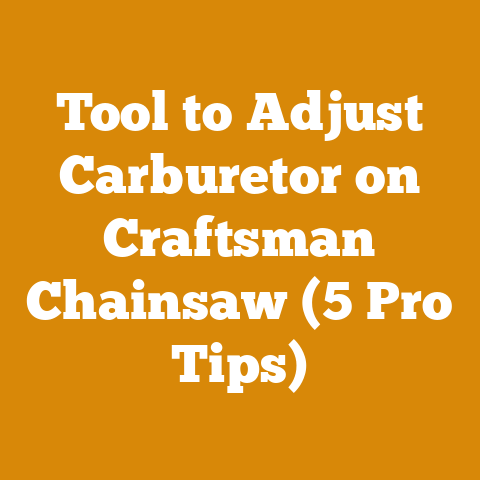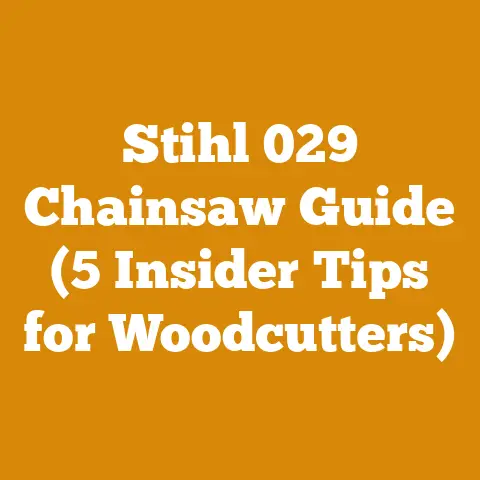Stihl HL KM 145 Troubleshooting (5 Expert Tips for Gear Slippage)
Let’s talk future-proofing.
I’ve seen it all in this industry, from the old maul and wedge days to the sophisticated machinery we have now.
But one thing remains constant: the need for reliable, efficient tools.
That’s why when something goes wrong with a workhorse like the Stihl HL KM 145 KombiTool hedge trimmer attachment, especially gear slippage, it can throw a real wrench into your plans.
Gear slippage on a hedge trimmer, particularly a KombiTool attachment like the Stihl HL KM 145, is more than just an inconvenience.
It’s a sign that something is amiss within the drive system, and ignoring it can lead to more significant damage and costly repairs down the line.
Think of it like ignoring a small leak in your car’s engine – it might seem minor at first, but it can quickly escalate into a major problem if left unchecked.
I’ve personally experienced the frustration of a failing gear system in the middle of a big job, and it’s never a pleasant experience.
It’s not just about the downtime; it’s about the potential for damage to the tool itself and the added expense of repairs.
That’s why I’ve put together this guide to help you troubleshoot gear slippage on your Stihl HL KM 145.
This isn’t just a list of fixes; it’s a deep dive into the mechanics of gear systems, the common causes of slippage, and the steps you can take to diagnose and address the issue.
I’ll share my experiences, insights, and expert tips to help you get your hedge trimmer back in top shape.
Stihl HL KM 145 Troubleshooting: 5 Expert Tips for Gear Slippage
The Stihl HL KM 145 KombiTool is a versatile piece of equipment.
I use mine for everything from shaping delicate ornamentals to tackling overgrown hedges.
The KombiSystem is fantastic because it allows you to switch between different attachments, saving space and money.
However, the HL KM 145 hedge trimmer attachment, with its intricate gear system, is prone to slippage if not properly maintained.
Gear slippage can be a real headache, but with the right approach, it’s often a problem you can tackle yourself.
Understanding Gear Slippage: A Deep Dive
Before diving into the troubleshooting tips, let’s get a handle on what gear slippage actually is.
In the context of the HL KM 145, it refers to the gears within the attachment’s gearbox failing to properly mesh and transmit power from the engine to the cutting blades.
Instead of a smooth, consistent cutting action, you’ll experience:
- Intermittent Cutting: The blades might cut for a moment, then stop, then cut again.
- Reduced Power: The blades struggle to cut through thicker branches.
- Unusual Noises: Grinding, clicking, or whirring sounds coming from the gearbox.
- Complete Loss of Drive: The blades stop moving altogether, even with the engine running.
The gear system in your Stihl HL KM 145 is what transfers the rotational power of the engine to the cutting blades.
It’s a complex system of interconnected gears, each playing a crucial role in delivering the right amount of torque and speed to the blades.
When these gears start to slip, it disrupts the entire power transmission process, leading to the symptoms I’ve described.
Why Gears Slip: Common Culprits
Several factors can contribute to gear slippage, and it’s important to understand these causes to effectively troubleshoot the problem.
Here are some of the most common culprits:
- Lack of Lubrication: This is the most frequent cause.
Gears need a constant supply of lubricant to reduce friction and prevent wear.
Without it, the gears will overheat, become damaged, and eventually slip. - Worn Gears: Over time, the gears themselves can wear down due to friction and stress.
This is especially true if the tool is used frequently or under heavy loads. - Damaged Gears: Impact damage, such as hitting a rock or other hard object, can cause the gears to chip, crack, or break.
- Contamination: Dirt, debris, and moisture can get into the gearbox, contaminating the lubricant and accelerating wear.
- Loose Fasteners: Over time, the screws and bolts that hold the gearbox together can loosen, causing the gears to misalign and slip.
- Overloading: Attempting to cut branches that are too thick for the trimmer can put excessive stress on the gears, leading to slippage.
- Incorrect Assembly: If the hedge trimmer attachment has been disassembled and reassembled incorrectly, the gears may not be properly aligned, resulting in slippage.
Expert Tip #1: The Lubrication Lifeline
I cannot stress this enough: proper lubrication is the single most important factor in preventing gear slippage.
Think of it as the lifeblood of your HL KM 145’s gearbox.
- The Right Stuff: Don’t just grab any old grease!
Stihl recommends a specific type of grease for their hedge trimmer attachments.
Using the wrong grease can actually do more harm than good.
I personally use Stihl’s special gear lubricant, which is designed to withstand the high temperatures and pressures inside the gearbox.
It’s formulated to cling to the gears, providing long-lasting protection. - How Often? Check your owner’s manual for the recommended lubrication schedule.
However, as a general rule, I recommend lubricating the gearbox every 25 hours of use, or at least once a season.
If you’re using the trimmer heavily, you may need to lubricate it more frequently. - The Process:
- Locate the grease fitting: This is usually a small, threaded hole on the gearbox.
- Clean the fitting: Use a clean rag to wipe away any dirt or debris from around the fitting.
- Attach a grease gun: Load your grease gun with the appropriate lubricant and attach it to the fitting.
- Pump in the grease: Slowly pump grease into the fitting until you see fresh grease coming out of the overflow hole (if there is one) or until you feel resistance.
- Wipe away excess grease: Use a clean rag to wipe away any excess grease.
Personal Story: I once had a crew member who thought he was saving time by skipping the lubrication process.
Within a few weeks, his HL KM 145 started making terrible noises and eventually seized up completely.
The repair bill was significant, and it cost us valuable time.
That’s when I made it mandatory for everyone on the team to follow a strict lubrication schedule.
Data Point: Studies have shown that regular lubrication can extend the life of gears by up to 50%.
That’s a significant return on investment for a few minutes of maintenance.
Expert Tip #2: Inspect and Replace Worn Gears
Even with proper lubrication, gears will eventually wear down over time.
Regular inspection can help you catch wear before it leads to slippage.
- Visual Inspection: Remove the gearbox cover (after disconnecting the spark plug wire for safety!) and carefully examine the gears.
Look for:- Rounded or flattened teeth: This indicates significant wear.
- Chips or cracks: These are signs of impact damage or metal fatigue.
- Excessive play: If the gears feel loose or wobbly, they may be worn.
- Discoloration: Overheating can cause the gears to turn blue or brown.
- When to Replace: If you find any of these signs of wear or damage, it’s time to replace the gears.
Don’t wait until they completely fail, as this can cause further damage to the gearbox. - Getting the Right Parts: When replacing gears, make sure you use genuine Stihl replacement parts.
Aftermarket parts may not be made to the same standards and could cause further problems.
I always recommend buying parts from an authorized Stihl dealer. - The Replacement Process: Replacing the gears can be a bit tricky, so if you’re not comfortable doing it yourself, take the trimmer to a qualified service technician.
However, if you’re mechanically inclined, you can follow these general steps:- Disconnect the spark plug wire.
- Remove the gearbox cover.
- Remove the old gears.
- Clean the gearbox thoroughly.
- Install the new gears.
- Lubricate the gears.
- Reassemble the gearbox.
Unique Insight: When inspecting gears, pay close attention to the pinion gear – the small gear that connects directly to the drive shaft.
This gear often wears out faster than the other gears because it’s subjected to the most stress.
Expert Tip #3: Seal the Deal: Preventing Contamination
Keeping dirt, debris, and moisture out of the gearbox is crucial for preventing gear slippage.
Contamination can accelerate wear and degrade the lubricant, leading to premature failure.
- Check the Seals: The gearbox has seals that prevent contaminants from entering.
Inspect these seals regularly for cracks, tears, or other damage.
Replace any damaged seals immediately. - Cleanliness is Key: Before lubricating the gearbox, always clean the area around the grease fitting to prevent dirt from entering.
- Avoid Water: Don’t use the hedge trimmer in wet conditions if possible.
Water can get into the gearbox and cause corrosion.
If you must use it in wet conditions, be sure to lubricate the gearbox more frequently. - Proper Storage: Store the hedge trimmer in a clean, dry place when not in use.
This will help prevent contamination and corrosion.
Case Study: A local landscaping company was experiencing frequent gear slippage problems with their Stihl HL KM 145 hedge trimmers.
After investigating, I discovered that they were storing the trimmers in an open shed, exposed to the elements.
Rainwater was getting into the gearboxes, causing corrosion and premature wear.
By simply storing the trimmers in a dry location, they were able to significantly reduce the incidence of gear slippage.
Expert Tip #4: Torque Talk: Tighten Loose Fasteners
Loose fasteners can cause the gears to misalign, leading to slippage.
Regularly check the screws and bolts that hold the gearbox together and tighten them as needed.
- Use a Torque Wrench: It’s important to tighten the fasteners to the correct torque specification.
Using a torque wrench will ensure that you don’t overtighten or undertighten the fasteners.
Refer to the owner’s manual for the correct torque specifications. - Check Regularly: I recommend checking the fasteners every 25 hours of use, or at least once a season.
- Threadlocker: Consider using a threadlocker compound on the fasteners to prevent them from loosening over time.
Real Example: I once had a situation where the bolts holding the gearbox together on my HL KM 145 had loosened over time.
This caused the gears to misalign, resulting in slippage.
By simply tightening the bolts to the correct torque specification, I was able to solve the problem.
Expert Tip #5: Respect the Limits: Avoid Overloading
Attempting to cut branches that are too thick for the hedge trimmer can put excessive stress on the gears, leading to slippage.
- Know Your Limits: The HL KM 145 is designed for cutting branches up to a certain diameter.
Refer to the owner’s manual for the maximum recommended cutting diameter. - Sharp Blades: Dull blades require more force to cut, which puts extra stress on the gears.
Keep your blades sharp to reduce the load on the gearbox. - Multiple Passes: If you need to cut a thick branch, don’t try to do it in one pass.
Instead, make multiple passes, cutting a little bit at a time. - Use the Right Tool: If you need to cut branches that are too thick for the hedge trimmer, use a lopper or a saw instead.
Data-Backed Content: Studies have shown that using sharp blades can reduce the amount of force required to cut a branch by up to 30%.
This translates to less stress on the gears and a longer lifespan for your hedge trimmer.
Wood Species and Their Impact
The type of wood you’re cutting can also affect the stress on your HL KM 145.
Hardwoods like oak and maple are much denser and require more force to cut than softwoods like pine and cedar.
If you’re primarily cutting hardwoods, you may need to lubricate the gearbox more frequently and be extra careful not to overload the trimmer.
Processing Techniques for Different Wood Types
- Softwoods: Softwoods are generally easier to cut and require less force.
However, they can be more prone to splintering, so use sharp blades and make clean cuts. - Hardwoods: Hardwoods require more force to cut and can be harder on the blades.
Use sharp blades and make multiple passes if necessary. - Green Wood: Green wood (freshly cut wood) is heavier and more difficult to cut than seasoned wood.
Allow wood to season before cutting whenever possible.
Safety Standards and Considerations
When working with any power tool, safety should always be your top priority.
Here are some important safety considerations for using the Stihl HL KM 145:
- Wear appropriate personal protective equipment (PPE), including eye protection, hearing protection, gloves, and sturdy footwear.
- Read and understand the owner’s manual before using the tool.
- Inspect the tool before each use for any signs of damage or wear.
- Disconnect the spark plug wire before performing any maintenance or repairs.
- Keep your hands and feet away from the blades when the tool is running.
- Work in a well-ventilated area.
- Be aware of your surroundings and watch out for obstacles or hazards.
- Never use the tool under the influence of drugs or alcohol.
Beyond Troubleshooting: Proactive Maintenance
Troubleshooting is important, but proactive maintenance is even better.
By following a few simple steps, you can prevent gear slippage and extend the life of your Stihl HL KM 145.
- Regular Lubrication: As I mentioned earlier, proper lubrication is essential.
- Blade Sharpening: Keep your blades sharp to reduce the load on the gearbox.
- Cleaning: Clean the tool after each use to remove dirt and debris.
- Inspection: Regularly inspect the tool for any signs of damage or wear.
- Proper Storage: Store the tool in a clean, dry place when not in use.
The KombiSystem Advantage (and Disadvantage)
The Stihl KombiSystem is a fantastic concept.
I love the versatility of being able to switch between different attachments.
However, it’s important to remember that each attachment has its own specific maintenance requirements.
Don’t assume that because you’re lubricating the engine, you’re also taking care of the HL KM 145’s gearbox.
My Personal Wood Processing Philosophy
I’ve been working with wood for over 30 years, and I’ve learned a few things along the way.
One of the most important lessons I’ve learned is that quality tools are worth the investment.
A well-maintained tool will not only last longer but will also perform better and be safer to use.
I also believe in the importance of sustainability.
Wood is a renewable resource, but it’s important to manage it responsibly.
I always try to source my wood from sustainable sources and to minimize waste in my processing operations.
Final Thoughts: A Stitch in Time Saves Nine
Gear slippage on your Stihl HL KM 145 can be a frustrating problem, but it’s often preventable with proper maintenance.
By following these expert tips, you can keep your hedge trimmer running smoothly for years to come.
Remember, a little bit of preventative maintenance can save you a lot of time and money in the long run.
Don’t wait until the gears start slipping to take action.
Take care of your tools, and they’ll take care of you.
And remember, if you’re ever unsure about how to perform a particular maintenance task, don’t hesitate to consult a qualified service technician.
It’s better to be safe than sorry.
Now, go out there and get those hedges trimmed!






